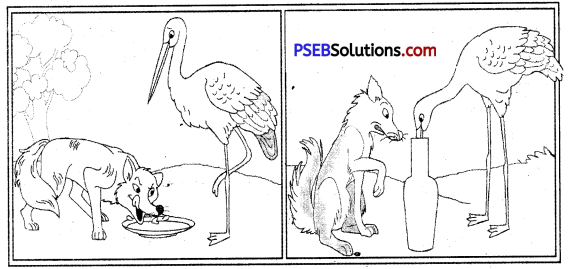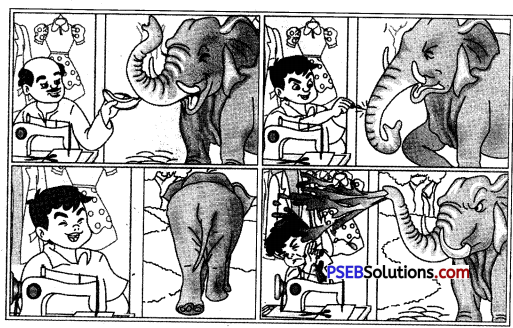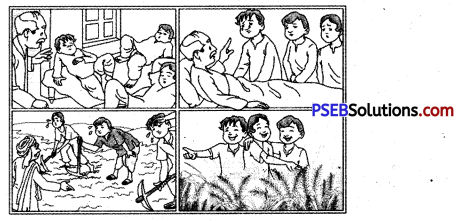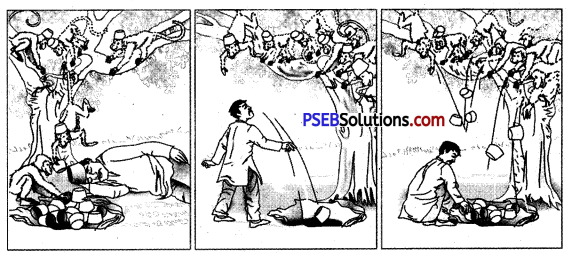Punjab State Board PSEB 9th Class Maths Book Solutions Chapter 13 Surface Areas and Volumes Ex 13.8 Textbook Exercise Questions and Answers.
PSEB Solutions for Class 9 Maths Chapter 13 Surface Areas and Volumes Ex 13.8
Question 1.
Find the volume of a sphere whose radius is
(i) 7 cm
Answer:
For the given sphere, radius r = 7 cm.
Volume of a sphere
= \(\frac{4}{3}\) πr3
= \(\frac{4}{3}\) × \(\frac{22}{7}\) × 7 × 7 × 7 cm3
= \(\frac{4312}{3}\) cm3
= 1437\(\frac{1}{3}\) cm3
![]()
(ii) 0.63 m.
Answer:
For the given sphere, radius r = 0.63 m.
Volume of a sphere
= \(\frac{4}{3}\) πr3
= \(\frac{4}{3}\) × \(\frac{22}{7}\) × 0.63 × 0.63 × 0.63 m3
= 1.05 m3 (approx.)
Question 2.
Find the amount of water displaced by a solid spherical ball of diameter
(i) 28 cm
(ii) 0.21 m
Answer:
Amount of water displaced by a solid spherical ball = Volume of spherical ball
(i) For the given spherical ball, diameter 28
radius r = \(\frac{\text { diameter }}{2}\) = \(\frac{28}{2}\) cm = 14 cm
Volume of spherical ball
= \(\frac{4}{3}\) πr3
= \(\frac{4}{3}\) × \(\frac{22}{7}\) × 14 × 14 × 14 cm3
= \(\frac{34496}{3}\) cm3
= 11498\(\frac{2}{3}\) cm3
Thus, the amount of water displaced by the given solid spherical ball is = 11498\(\frac{2}{3}\) cm3
![]()
(ii) For the given spherical ball, diameter 28
radius r = \(\frac{\text { diameter }}{2}\) = \(\frac{0.21}{2}\) m
Volume of spherical ball
= \(\frac{4}{3}\) πr3
= \(\frac{4}{3}\) × \(\frac{22}{7}\) × \(\frac{0.21}{2}\) × \(\frac{0.21}{2}\) × \(\frac{0.21}{2}\) m3
= 11 × 0.01 × 0.21 × 0.21 m3
= 0.004851 m3
Thus, the amount of water displaced by the given solid spherical ball is 0.004851 m3.
Question 3.
The diameter of a metallic ball is 4.2 cm. What is the mass of the ball, if the density of the metal is 8.9g per cm3?
Answer:
For the given spherical ball,
radius r = \(\frac{\text { diameter }}{2}\)
= \(\frac{4.2}{2}\) cm
= 2.1 cm
= \(\frac{21}{10}\) cm
Volume of a sphere
= \(\frac{4}{3}\) πr3
= \(\frac{4}{3}\) × \(\frac{22}{7}\) × \(\frac{21}{10}\) × \(\frac{21}{10}\) × \(\frac{21}{10}\) cm3
= 38.808 cm3
Now, the density of the metal of the ball is 8.9 g per cm3.
∴ Mass of the ball = Volume × Density
= 38.808 cm3 × 8.9 g/cm3
= 345.39 g (approx.)
Thus, the mass of the metallic ball is 345.39 g (approx.).
![]()
Question 4.
The diameter of the moon is approximately one-fourth of the diameter of the earth. What fraction of the volume of the earth is the volume of the moon ?
Answer:
As the diameter of the moon is one-fourth of the diameter of the earth, the radius of the moon is also one-fourth of the radius of the earth. In other words, the radius of the earth is four times the radius of the moon. Let, the radius of the moon be r and the radius of the earth be R.
Then, R = 4r
Now, \(=\frac{\text { volume of the moon }}{\text { volume of the earth }}\) = \(\frac{\frac{4}{3} \pi r^{3}}{\frac{4}{3} \pi R^{3}}\)
= \(\left(\frac{r}{R}\right)^{3}\)
= \(\left(\frac{r}{4 r}\right)^{3}\)
= \(\left(\frac{1}{4}\right)^{3}\)
= \(\frac{1}{64}\)
∴ Volume of the moon
= \(\frac{1}{64}\) × Volume of the earth
Thus, the volume of the moon is \(\frac{1}{64}\) times the volume of the earth.
Question 5.
How many litres of milk can a hemispherical bowl of diameter 10.5 cm hold?
Answer:
For the hemispherical bowl,
radius r = \(\frac{\text { diameter }}{2}\)
= \(\frac{10.5}{2}\) cm
= 5.25 cm
= \(\frac{21}{4}\) cm
Capacity of the hemispherical bowl
= Volume of a hemisphere
= \(\frac{2}{3}\) πr3
= \(\frac{2}{3} \times \frac{22}{7} \times \frac{21}{4} \times \frac{21}{4} \times \frac{21}{4}\) cm3
= 303.19 cm3 (approx.)
= \(\frac{303.19}{1000}\) liters (approx.)
= 0.303 liters (approx)
Thus, the given hemispherical bowl can hold 0. 303 litres (approx.) of milk.
![]()
Question 6.
A hemispherical tank is made up of an iron sheet 1 cm thick. If the inner radius is 1 m, then find the volume of the iron used to make the tank.
Answer:
For the hemispherical tank, inner radius r = 1 m and the thickness of the iron sheet = 1 cm = 0.01 m.
∴ For the hemispherical tank, outer radius
R = 1 + 0.01 m = 1.01 m.
Volume of the iron used in the tank
= Volume of outer hemisphere – Volume of Inner hemisphere
= \(\frac{2}{3}\) πR3 – \(\frac{2}{3}\) πr3
= \(\frac{2}{3}\) π (R3 – r3)
= \(\frac{2}{3}\) × \(\frac{22}{7}\) (1.013 – 13) m3
= \(\frac{44}{21}\) (1.030301 – 1) m3
Thus, the volume of the iron used to make the tank is 0.06349 m3 (approx.).
Question 7.
Find the volume of a sphere whose surface area is 154 cm2.
Answer:
For the given sphere, surface area = 154 cm2.
Surface area of a sphere = 4πr2
∴ 154 cm2 = 4 × \(\frac{22}{7}\) × r2cm2
∴ r2 = \(\frac{154 \times 7}{4 \times 22}\) cm2
∴ r2 = \(\frac{49}{4}\) cm2
∴ r = \(\frac{7}{2}\)
Thus, the radius of the given sphere is \(\frac{7}{2}\) cm.
Volume of a sphere
= \(\frac{4}{3}\) πr3
= \(\frac{4}{3} \times \frac{22}{7} \times \frac{7}{2} \times \frac{7}{2} \times \frac{7}{2}\) cm3
= \(\frac{539}{3}\) cm3
= 179\(\frac{2}{3}\) cm3
Thus, the volume of the given sphere is 179\(\frac{2}{3}\) cm3.
![]()
Question 8.
A dome of a building is in the form of a hemisphere. From inside, it was white washed at the cost of ₹ 4989.60. If the s cost of whitewashing is ₹ 20 per square metre, find the
(i) inside surface area of s the dome.
Answer:
(i) Area of the region whitewashed at the
cost of ₹ 20 = 1 m2
∴ Area of the region whitewashed at the cost of ₹ 4989.60 = \(\frac{4989.60}{20}\) m2 = 249.48 m2
Hence, the inner surface area of the dome is 249.48 m2
(ii) volume of the air inside the dome.
Answer:
Curved surface area of hemispherical dome = 2πr2
∴ 249.48 m2 = 2 × \(\frac{22}{7}\) × r2 m2
∴ r2 = \(\frac{249.48 \times 7}{2 \times 22}\) m2
∴ r2 = 39.69 m2
∴ r2 = \(\sqrt{39.69}\) m
∴ r = 6.3 m
Thus. the radius of the hemispherical dome is 6.3m.
Volume of air inside the hemispherical dome = Volume of a hemisphere
= \(\frac{2}{3}\) πr3
= \(\frac{2}{3}\) × \(\frac{22}{7}\) × 6.3 × 6.3 × 6.3 m3
= 523.908 m3
= 5239 m3 (approx.)
Thus, the volume of the air inside the dome is 523.9 m3 (approx.).
![]()
Question 9.
Twenty-seven solid iron spheres, each of radius r and surface area S are melted to form a sphere with surface area S’, Find the
(i) radius r’ of the new sphere,
Answer:
(i) 27 solid iron spheres of radius r are melted to form 1 iron sphere of radius r’.
∴ Volume of 1 sphere of radius r’
= Volume of 27 spheres of radius r
∴ \(\frac{4}{3}\) πr’3 = 27 × \(\frac{4}{3}\) πr’3
∴ r’3 = 27r3
∴ r’3 = (3r)3
∴ r’ = 3r
(ii) ratio of S and S’.
Answer:
The surface area of the sphere with radius r is S and the surface area of the sphere with radius r’ is S’.
Then,
\(\frac{\mathrm{s}}{\mathrm{S}^{\prime}}=\frac{4 \pi r^{2}}{4 \pi r^{\prime 2}}=\frac{r^{2}}{r^{\prime 2}}=\frac{r^{2}}{(3 r)^{2}}=\frac{r^{2}}{9 r^{2}}=\frac{1}{9}\) = 1 : 9
Thus, the ratio of S and S’ is 1 : 9.
![]()
Question 10.
A capsule of medicine is in the shape of a sphere of diameter 3.5 mm. How much medicine (in mm3) is needed to fill this capsule ?
Answer:
For the spherical capsule, radius r = \(\frac{\text { diameter }}{2}\)
= \(\frac{3.5}{2}\) mm
= 1.75 mm
Capacity of the spherical capsule
= Volume of a sphere
= \(\frac{4}{3}\) πr’3
= \(\frac{4}{3}\) × \(\frac{22}{7}\) × 1.75 × 1.75 × 1.75 mm3
= 22.46 mm3 (approx.)
Thus, 22.46 mm3 (approx.) medicine is needed to fill the given capsule.










